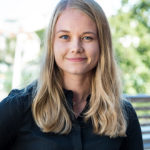
In order to gain valuable insights and try out what it is really like working in an industry, at a company or before even settling on a career path, an internship is a perfect position. All questions you may have, such as what the company does, what kind of tasks there are, what the corporate culture is like, are just a few examples of what an internship can provide answers for. This summer Anna, Felix, and Shadali has had the chance to figure out more about MSC and gain some real work life experience. To learn more about their experiences as interns during the summer, we asked them for their thoughts.
 Anna, Communication intern
Anna, Communication intern
My name is Anna and I’ve got a bachelor’s degree in Biotechnology. This September, I’m starting the last year of my master’s Entrepreneurship and Business Design, at the Chalmers University of Technology. In my spare time, I love playing handball, traveling and hanging out with friends and family. Don’t be surprised to see me with a camera in my hand or making cookies since photography and baking are two other interests of mine.
 Felix, Analyst intern
Felix, Analyst intern
My name is Felix and I’m studying the Entrepreneurship and Business Design master’s program after my bachelor’s in Biotechnology at Chalmers University of Technology. I’m a lively guy who like finding new interesting projects to do whether it is getting into new sports, buying a 3D printer and in the past, I’ve also been a frequent sailor competitively and leisurely.
 Shadali, Analyst intern
Shadali, Analyst intern
I’m Shadali, an engineer in Biotechnology (from India), currently enrolled in the master’s program of Bioentrepreneurship at Karolinska Institutet. I always had a keen interest in the life sciences industry and its developments, but never felt like a perfect fit in the laboratory setup. Life took its course and here I am now, far away from home working as an intern Analyst at MSC. Besides this, I’m the kind of person that can spend my days with a canvas, some paint and mellow indie acoustic music playing in the background.
“Take MSC as Hogwarts where help will always be given to those who ask for it/deserve it. The moral being: Never hesitate to clear your doubts when required.” – Shadali
What did you work with during your internship?
Anna: During this summer, I’ve got to work on a variety of different communication tasks, both internally and for our life science clients. I’ve been assisting and creating content for our social media as well as analyzing our social media strategy to see what is working and not. Apart from that, I’ve written press releases, edited annual reports, drafted word of the CEO, created website content to name a few assignments. I was fortunate enough to also experience business analyst assignments, helping out with research and data analysis for a big client, which was one of the biggest projects we had this summer. So, all in all, I got to see both the communication and the strategy side, which truly is ideal when getting to know the company.
Felix: During my time as an intern, most of my involvement has been directed towards one of our bigger clients. I’ve had to use all my knowledge about therapeutic areas, biotechnology methods and more that I’ve previously gained from my education in order to find relevant information to use for expert profiling, company presentations etc. Aside from that, I’ve also been producing competitive intelligence reports and market analysis for some of the smaller clients, which all have been a great deal of fun.
Shadali: From this internship opportunity, I indented to develop a deeper understanding of the business aspect of the life sciences industry. I’ve worked with a variation of tasks, where some required involvement for a shorter span and others for a longer period of time. Moreover, I also found myself working for different clients ranging from big pharmaceuticals to smaller life science companies. I performed tasks such as expert landscaping, data curation, participating in orphan drug designation discussions, and working on investor presentations.
What was the biggest learning from your internship and how did it prepare you for your future career?
Anna: Here at MSC, I’ve gotten a great insight of the work with biotech companies but from a business perspective. Realizing how the work with clients can be and how much of the client’s internal politics you have to navigate has been eye-opening, not only for future professional endeavors but also for my master thesis project I’ve upcoming this year. Furthermore, I learned to be prepared for unexpected events, such as change of project scope and deadlines, and being able to deal with challenges daily will be useful no matter what work place you are at. Besides work, I’ve gotten to know some great colleagues, and their talent has been a great source of inspiration.
Felix: The biggest learning for me was both to understand how client contact and project management work at a consulting firm like MSC, and more than anything about how to tailor the deliverables towards the client. Within consulting, I’ve come to realize that there is a fine line between overworking things and not being thorough enough; and finding that line has for sure been an interesting challenge. These learnings, I believe, are going to be crucial whether or not I end up at a consulting firm in the future but also for all things entrepreneurial given the constant client-facing and service-minded thinking.
Shadali: As of now, I’ve worked here for a relatively shorter span of time but there already are so many learning that I can think of that can fit into my list of learnings. Apart from the getting to work and experiment with amazing tools such as the Monocl platform, the biggest learning is to practically see how a consulting firm such as MSC bridges the gap between laboratory and the industry. An example of this is an ODD discussion I was sitting in on supporting a senior colleague at MSC. I could see how someone so young from the MSC team with a similar background as mine was leading, directing and guiding a discussion between the client and a third-party vendor, two teams each comprising of experts and highly experienced members in their respective domains. Honestly, I was able to spot how the output of the meeting would have been so different (not very positive) in the absence of the MSC team member.
What advice would you give to future interns?
Anna: One of the best things I think you can do during the internship is to seize the opportunity and challenge yourself by doing many different tasks. That might mean that you will do things you are not best at, but you will learn a lot, which is something no one can take away from you. And don’t be afraid to ask questions and learn from your colleagues. Just be honest about what you have done and what you need extra help with and everything else will fall into place.
Felix: For future interns, I would say to make sure to set aside a little time to learn the methodology of what you are going to do because it will make all similar work quicker in the future. At the same time, though, try to always put the work in relation to what you are going to achieve and don’t be daunted by how many people rely on what you are producing, instead just do your very best and everything will turn out great. Also, everyone makes mistakes and the sooner you accept and stand up for it the better you will get.
Shadali: My advice for a future intern is to be vigilant and absorb as much as possible from this opportunity. I see MSC as a firm that is involved and concerned with the learning experience it provides to its interns. Hence one will get open access to the discussions. It’s in our hands to make the most out of this environment. Also, even if you come from the ‘perfect’ background, it’s important to understand that life science, in general, is a complex field. So, don’t get overwhelmed with the flowing information and work according to your learning graph. The team is super supportive. Take MSC as Hogwarts where help will always be given to those who ask for it/deserve it. The moral being: Never hesitate to clear your doubts when required.
If you’re interested in an internship position at MSC, do feel free to reach out to Tove (tove.bergenholt@monocl.com).



